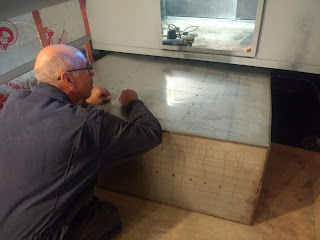Some of the key things which were still outstanding:
- Mate the gearbox to the engine
- Order the propshaft and fit
- Soundproof generator housing
- Install the generator
- Install the alternator on a bespoke bracket
- Install the thrust bearing and remote greaser
- Pack the stern gland
- Install the bilge pump
- Install locks to the main doors
- Install the water tank
- Get the cooker off the ballast blocks to get floor finished
- Start on battening and insulating
- Fit the portholes, hatch and door windows.
- Make and fit guards to cover moving engine parts
- Secure the cooker ready for transport
- Burn holes for chimneys, bilge pumps, etc
These were just the main jobs. In between were dozens of smaller jobs which had to be done to get the bigger tasks completed. The major, pain the backside job was to mate the gearbox to the engine (which has no bell housing). I'd already bought an R&D damper plate. This is a round plate with a splined socket to match the shaft on the gearbox. It also has shock absorbers built in. The difficulty was fitting it to the flywheel, so I had to get a custom-made adapter to join the two together.
So far, so good. The big problem was to ensure the spline was accurately aligned - not easy when you have a 65Kg lump dangling from the end of a chain! Then a secondary plate had to be fabricated to support the main gearbox plate.
After about a day's work, the spline was finally slid into position and the massive support bracket was welded in place.
Now we knew the distance from the prop shaft to the gearbox flange, I could order the main propshaft. When this arrived, it was disappointingly too short and refused to mate with the gearbox. 4 hours later, after a great deal of cursing, filing and hammering, it finally went into place and was bolted up. It was now 9pm on Saturday 6th. Three and a half days left to complete everything else!

Resigned to the fact that sleep was now a luxury, I got into a routine of starting work at 6.30am and finishing at midnight or later.
Next job was to line out the generator pod in the Potter's locker with heavy duty soundproofing material.and bolt in the massive slide rails.
In an effort to reduce the amount of material which would have to get loaded in the boat, I cracked on with battening and fitting some of the 50mm Celotex.
Now the generator could be loaded... the 150Kg lump was hoisted up with the forklift and painstakingly eased into position. All that careful measuring paid off! It fitted within a few millimetres and dropped onto the support rails, ready for bolting and welding.
With about 2 days before the crane was due, the portholes (ordered 4 months previously) started arriving in dribs and drabs. I was very anxious to ensure that the boat would be watertight before leaving the shed. In the end, she was rolled out minus two chimey collars and the Houdini hatch.
Just hours before the lorry was due, we attempted the installation of the water tank. We knew it wouldn't go through the front doors, so it had to be manhandled through the stern doors, then turned horizontal to allow it to go over the engine.
We were all mighty relieved when it went into place, only needing an inch chopping off the breather pipe to get it to clear.
Murray was thrashing on with burning the required holes in the cabin and hull, fitted the pole & plank rack and refitted the hatch, which I had just lined with ply.
Just to add to my rising sense of panic, the lorry and crane arrived an hour early! We still had a list of jobs to complete, but the main task now was to secure the cooker on a platform with ratchet straps. This was vital, to prevent it moving in transit. That done, we then started chucking all the tools, equipment and materials on board. There was no time to do the job neatly - it would all have to be sorted later. By this point, I was close to complete exhaustion and was relieved to be able to hand over responsibility to Garry and the team, to get the boat loaded. See next blog, to follow soon!















No comments:
Post a Comment